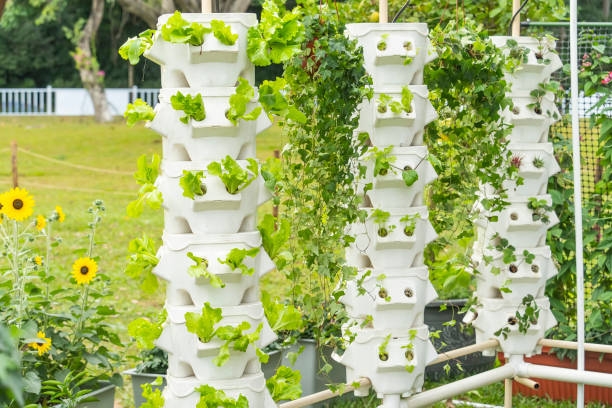Exploring the Wonders of Hydroponic Towers: A Revolution in Vertical Gardening

Hydroponic towers are transforming the way we grow plants, providing a modern and efficient alternative to traditional soil-based gardening. A hydroponic tower is a vertical garden system that uses hydroponic techniques to grow plants without soil, making it an ideal solution for people who want to grow fresh produce in limited spaces. These vertical gardens are becoming more popular, especially among urban gardeners and individuals living in apartments, as they offer many advantages like saving space, using less water, and producing more food.
What is a Hydroponic Tower Garden?
A hydroponic tower garden is a vertical growing system where plants are nourished with water that contains essential nutrients. Unlike traditional gardening, hydroponic gardening doesn’t require soil. The plants are supported by net pots, and the water is circulated through the tower, providing moisture and nutrients directly to the roots. The design of the tower allows for maximum plant growth in small areas, making it an ideal option for city dwellers who may not have access to a backyard.
Benefits of Hydroponic Towers
-
Space Efficiency: One of the key benefits of using hydroponic towers is their space-saving design. Vertical gardens maximize the available space by growing plants upwards, rather than outwards. This makes them perfect for small homes, apartments, and balconies where traditional gardening might not be feasible.
-
Water Conservation: Hydroponic systems use significantly less water than traditional soil-based gardening. The water is recycled in the tower system, reducing waste and ensuring that plants receive just the right amount of moisture.
-
Faster Growth: Plants grown in hydroponic towers tend to grow faster than those grown in soil. This is because hydroponic systems deliver nutrients directly to the plant roots, promoting rapid growth. Additionally, since the plants are not competing for nutrients in the soil, they can focus on growing larger and healthier.
-
No Soil, No Mess: The absence of soil in hydroponic towers eliminates the mess typically associated with traditional gardening. This makes hydroponic gardening a clean and efficient way to grow your own vegetables and herbs indoors or outdoors.
-
Increased Yield: Hydroponic systems tend to have higher yields per square foot compared to traditional gardening. By using vertical gardening techniques, you can produce more food in less space.
How to Grow with Hydroponic Towers
1. Germination:
Start by planting your seeds in the provided rockwool cubes, which are specially designed to promote germination. Once the seeds sprout, they are ready to be transferred into the hydroponic tower.
2. Plant Transfer:
Once the seedlings are ready, transfer them into the net pots in the tower. The net pots hold the plants securely, and their roots will be nourished by the nutrient-rich water that circulates through the system.
3. Harvesting:
In about three weeks, your plants will be ready for harvest. With a hydroponic tower garden, you can enjoy fresh, organic produce, including leafy greens, herbs, and even small fruits like strawberries and tomatoes.
Hydroponic Towers: A Sustainable Solution for Urban Gardens
Hydroponic towers are especially beneficial for people living in urban areas with limited outdoor space. They offer a sustainable way to grow fresh food in small spaces like apartments, rooftops, and balconies. These vertical garden use less water, require no soil, and provide faster harvests, making them a smart choice for anyone looking to grow food sustainably.
The Role of Hydroponic Towers in Sustainable Living
Hydroponic towers play a significant role in promoting sustainable living. They reduce the need for large plots of land, cut down on water consumption, and eliminate the use of pesticides and fertilizers commonly used in traditional agriculture. With the rise in eco-conscious consumers, vertical gardens are becoming a key part of the future of home gardening and sustainable living.
Conclusion: Why Hydroponic Towers Are the Future of Urban Gardening
Hydroponic towers are revolutionizing the way we grow food at home. Their space-saving design, water efficiency, and ability to produce faster, healthier crops make them an excellent choice for anyone looking to adopt a more sustainable lifestyle. Whether you're growing fresh herbs for your kitchen or cultivating leafy greens for your family, a hydroponic tower garden provides an innovative solution that is both efficient and eco-friendly.
The ALTO Garden GX Tower is one such innovative solution that allows you to grow fresh, organic produce right at home, all year round. With its space-saving design, advanced features, and sustainability benefits, it’s an excellent option for anyone interested in hydroponic gardening. Whether indoors or outdoors, the ALTO Garden GX Tower can help you create a thriving garden with minimal effort and maximum results.
- Questions and Answers
- Opinion
- Motivational and Inspiring Story
- Technology
- Live and Let live
- Focus
- Geopolitics
- Military-Arms/Equipment
- Seguridad
- Economy
- Beasts of Nations
- Machine Tools-The “Mother Industry”
- Art
- Causes
- Crafts
- Dance
- Drinks
- Film/Movie
- Fitness
- Food
- Juegos
- Gardening
- Health
- Home
- Literature
- Music
- Networking
- Other
- Party
- Religion
- Shopping
- Sports
- Theater
- Health and Wellness
- News
- Culture

